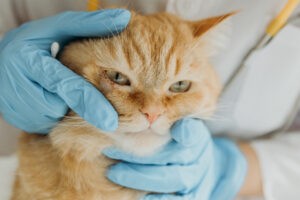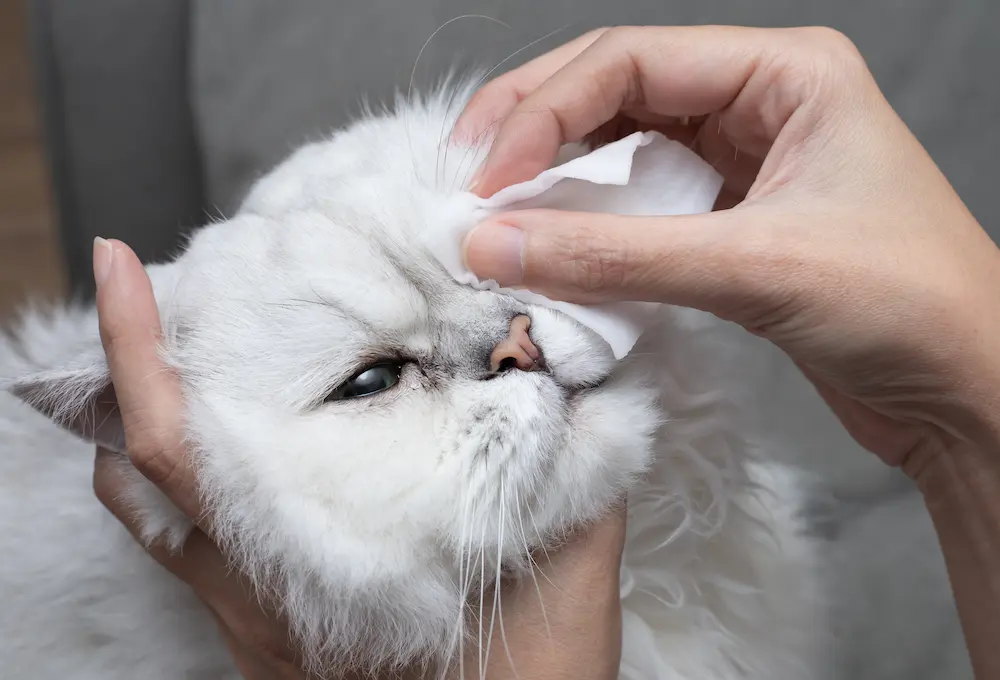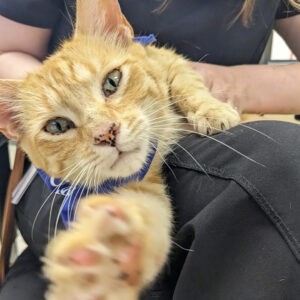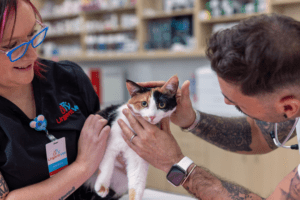Conjunctivitis is a common condition in cats, ranging from kittens to older felines. Whether you’re worried your kitten might be showing signs of kitten conjunctivitis or you simply want to learn more about cat eye infections, this guide will walk you through everything you need to know about this frequent issue. We’ll cover key topics, including cat conjunctivitis symptoms, how to treat conjunctivitis in cats, whether or not your cat may be more susceptible to the condition, and more.
What is Conjunctivitis in Cats?
Conjunctivitis is a medical condition in which the conjunctiva, the mucous membrane covering the front of the eye and lining the inside of the eyelids, becomes inflamed. This inflammation can cause the eye to appear pink or red and is often accompanied by discomfort, eye discharge, and itchiness. In cats, conjunctivitis can affect one eye (unilateral) or both eyes (bilateral) and can range from mild irritation to severe inflammation, impacting the cat’s overall well-being and comfort.
Types of Conjunctivitis in Cats
Cats can suffer from various types of conjunctivitis, each characterized by different causes and requiring specific approaches to treatment:
- Infectious Conjunctivitis: This type is caused by pathogens such as bacteria (e.g., Chlamydophila felis) or viruses (especially Feline Herpesvirus-1). Infectious conjunctivitis is highly contagious among cats and can cause severe redness, swelling, and discharge.
- Allergic Conjunctivitis: Triggered by environmental allergens such as pollen, dust, or mold, allergic conjunctivitis in cats results in itching, redness, and watery discharge. It’s more common during certain times of the year, similar to seasonal allergies in humans.
- Chemical Conjunctivitis: This form of conjunctivitis can be caused by exposure to irritants like smoke, shampoo, or other chemicals. It usually clears up once the irritant is removed, though flushing the eye with saline can help alleviate symptoms.
- Neonatal (Kitten) Conjunctivitis: Kittens can suffer from conjunctivitis shortly after birth, often resulting from a bacterial infection or being born in unsanitary conditions. It is critical to treat this promptly to prevent long-term damage to the kitten’s eyesight.
- Traumatic Conjunctivitis: Physical injury to the eye, whether from scratches, foreign bodies, or blunt trauma, can lead to conjunctivitis. This type often presents with redness and discharge, and immediate veterinary care is necessary to prevent further complications.

Each type of conjunctivitis might exhibit unique symptoms, and a veterinary exam will be required to determine the exact cause and best treatment plan.
Which Cats Are Prone to Conjunctivitis?
While any cat can develop conjunctivitis, certain factors may increase susceptibility. Kittens, due to their developing immune systems, and older cats with diminished health, are more prone to infections. Cats with compromised immune systems, such as those with FIV (Feline Immunodeficiency Virus) or FeLV (Feline Leukemia Virus), are also at a higher risk.
It is also of note that around 80-90% of cats are exposed to Feline Herpesvirus-1 (FHV-1) at some point in their lives, and many become latent carriers. It’s estimated that up to 70% of these carriers may not exhibit symptoms unless reactivated by stress or immunosuppression.

Signs and Symptoms of Conjunctivitis in Cats
So, how do you know if your cat has pink eye? There are many different symptoms that can be a clue that your feline friend has an eye infection of some sort, including:
Redness and Swelling
One of the most noticeable signs of conjunctivitis is the reddening and swelling of the membranes around the eyes. This inflammation can make the eyes appear very red and puffy.
Excessive Blinking or Squinting
Cats with conjunctivitis often exhibit increased blinking or squinting. This reaction is a natural response to discomfort or an attempt to remove irritants from the eye surfaces.
Discharge
When it comes to conjunctivitis, cat eye discharge can vary depending on the underlying cause. It may be clear and watery, suggesting a viral origin, or thick and colored (yellow or green), which typically indicates a bacterial infection. This discharge is an important part of the diagnosis as it not only affects the cat’s comfort but also can lead to the crusting of the eyes after sleep.
Visibility of the Third Eyelid
If you have heard of the feline third eyelid, cat conjunctivitis can sometimes lead to this part of the eye becoming more prominent, with the eyelid even covering a significant portion of the eyeball. This phenomenon can be very concerning for cat owners, but it actually serves as a protective mechanism for the eye.
Behavioral Changes
Cats experiencing eye discomfort may attempt to relieve irritation by pawing at their eyes, which can exacerbate the condition. Additionally, the constant irritation from conjunctivitis can make a cat more irritable or aggressive, particularly when attempts are made to examine their eyes.
Avoidance of Light
Pets with severe cat conjunctivitis may seek darker places, indicating sensitivity to light – a symptom known as photophobia. This behavior is due to the pain and discomfort caused by bright lights on the inflamed eyes.
Reduced Eye Function
In serious cases, conjunctivitis can impair vision, which is observable as a hesitance to navigate familiar environments or misjudging distances, which might manifest in clumsiness or accidents.

Causes: How do Cats Get Conjunctivitis?
In terms of the causes of cat conjunctivitis, there are many different factors that can come into play, which usually fall into one of two categories: infectious and non-infectious causes.
Infectious Causes
The primary infectious agents are feline herpesvirus and calicivirus, which account for a significant number of eye infection cases in cats. Bacterial infections, though less common, can also lead to conjunctivitis.
Non-Infectious Causes
Allergens like pollen, dust, and smoke can irritate the conjunctiva, leading to allergic conjunctivitis. Physical irritants like shampoo or foreign bodies like dust particles can also cause the condition.
Diagnosing Conjunctivitis in Cats
Diagnosing conjunctivitis in cats is a meticulous process that involves a combination of clinical assessment and diagnostic tests to ensure accurate identification of the type and cause of the infection. Early diagnosis is crucial in managing the condition effectively and preventing potential complications that could affect the cat’s vision and overall eye health.
The process begins with a detailed examination by a veterinarian. The vet will thoroughly inspect the affected eye or eyes, looking for visible signs of redness, discharge, swelling, and any abnormalities in the eyelid or surrounding tissues. This initial examination helps to assess the severity and extent of the inflammation.
Then, depending on their assessment, the veterinarian may suggest one or more of these tests:
Fluorescein Eye Stain Test
This diagnostic tool is essential for detecting corneal ulcers or any abrasions on the surface of the eye. The veterinarian applies a non-toxic dye to the eye, which adheres to any damaged areas, making them glow under a blue light. This test is painless and provides immediate results, helping to rule out or confirm corneal injuries that could complicate conjunctivitis.
Schirmer Tear Test
To get more information about a cat’s tear production, which is crucial for eye health and can affect conjunctivitis, the Schirmer tear test is performed. A small strip of paper is placed inside the lower eyelid, and the amount of wetting of the paper over a set period is measured. Inadequate tear production can indicate dry eye syndrome, which may exacerbate or mimic conjunctivitis symptoms.
Microbiological Testing
If an infectious cause is suspected, samples of the discharge may be taken for bacterial cultures or viral identification. This helps in pinpointing the specific pathogen responsible, thereby allowing for targeted treatment strategies.
Allergy Testing
For cats with suspected allergic conjunctivitis, allergy testing may be necessary to identify potential allergens causing eye irritation. This might involve skin or serum tests and requires detailed knowledge of the cat’s environment and history to determine potential allergens.
Additional Imaging
In some cases, further diagnostic imaging, such as an ultrasound or an MRI, might be required to examine deeper structures of the eye and surrounding tissues, especially if an underlying systemic condition is suspected.

Treatment for Conjunctivitis in Cats
Is there a cure for conjunctivitis in cats?
Yes, feline conjunctivitis can absolutely be treated and cured. Ultimately, treatment depends on the underlying cause.
- Infectious Conjunctivitis: Treatment typically involves topical antibiotics or antiviral medications for bacterial and viral infections, respectively.
- Allergic Conjunctivitis: Antihistamines and corticosteroids may be prescribed to reduce inflammation and treat symptoms.
- Environmental Modifications: Reducing your cat’s exposure to known irritants can help prevent the recurrence of allergic conjunctivitis.
What happens if cat conjunctivitis is not treated?
If cat conjunctivitis is not treated, it can lead to more serious complications. Untreated, the inflammation can cause chronic eye irritation, damage to the cornea, and potentially, vision loss.
Persistent infection and inflammation can also lead to deeper eye infections or spread to other parts of the body. Additionally, underlying causes such as infections or allergies in cats will continue to affect the felines overall health if not addressed, leading to a decline in quality of life and potentially more severe health issues.
Visit UrgentVet for Safe, Effective Treatment of Eye Infection in Cats
If you suspect your cat is suffering from conjunctivitis, it’s important not to delay treatment. Early intervention is crucial to prevent complications such as keratitis or corneal ulcers, especially in cases of severe cat conjunctivitis.

At UrgentVet, we’re equipped to diagnose and treat pink eye in cats effectively. Our clinics are open 365 days a year, and walk-in visits are always welcome, providing you with access to immediate care when your cat needs it most. With state-of-the-art facilities and a compassionate approach, we ensure your pet gets the best possible care for a swift recovery.
For cat eye infection treatment or assistance with a wide range of other common cat illnesses, find an UrgentVet location near you for cat veterinary urgent care.
Image Credit: catinsyrup / Shutterstock




